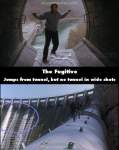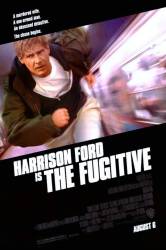Continuity mistake: When Richard Kimble and the one armed man are fighting in the train, it shows from the outside of the train the one armed man stumbling backward. It shows his "prosthetic" hand grabbing for the pole.

Continuity mistake: Kimble dives from the top of the dam when Gerard traps him in the tunnel. But in wide shots of Kimble falling, there's no tunnel above the dam. (The tunnel scenes were shot in Chicago, but the location sequences were done at Cheoah Dam in North Carolina - which has no tunnels. The end of the tunnel from which Harrison Ford supposedly jumped was built on the back of a large flatbed truck which was driven out on the top of the dam for the scene).
Continuity mistake: When Kimble is fighting the one-armed man on the train, the one-armed man shoots the metro-cop, then he and Kimble fight some more. Kimble knocks him out with his gun (silver). He goes to check on the cop, sees he's dead so he takes his cuffs and gun (black). He cuffs the one-armed man to the rail puts his gun (silver) into his right pocket, and the cops gun (black) into his left pocket, and then makes his escape. Later on, he dumps the guns into a mailbox, but he pulls the silver gun out of his left pocket, and the black gun out of his right pocket. The guns changed pockets before he dumped them.
Continuity mistake: Kimble runs out the Grand Ballroom and ends up in the Presidential Suite in another fight. The doors he goes through out of the Ballroom actually lead into the Foyer for the Continental Ballroom, both of which are on the second floor. That Presidential Suite is on the 27th Floor.
Continuity mistake: During the scene where Kimble is running from the dam, his hair is all messy and wet. yet, when he falls over into the leaves several shots later, his hair is nicely combed with a parting.
Revealing mistake: During the St. Patrick's Day parade, Kimble removes his coat. In the next scene, he hasn't got the coat anymore, and he HASN'T dropped it. Don't be fooled. If you look to his right in the scene just after he takes it off, you can see a man carrying a coat that is the exact same colour and design. I assume this guy is supposed to be hiding the coat from view, but you can plainly see it. The guy is wearing a green hat. Kimble had no time to give it to him before the scenes changed.
Continuity mistake: When Richard Kimble is being chased by Tommy Lee Jones in the St. Patrick's Day parade, there are three clock shots (on sides of buildings and whatnot), all of which show totally different times.
Revealing mistake: When Kimble jumps from the dam, the falling body is clearly a dummy, otherwise he broke every single bone in his body before he even jumped.
Continuity mistake: After Kimble escapes from the prison bus moments before it's demolished by a train, he steals an ambulance, is chased through the mountains by a police helicopter, is trapped in a tunnel, escapes by crawling through a drain and jumping from a very tall dam into a raging river. A very thrilling sequence, but he's supposed to be in Illinois, where there is no terrain remotely resembling this.
Continuity mistake: During the scene in the dam tunnels, Kimble holds Gerard at gunpoint. In the first close-up, Gerard has three strands of hair that are all apart from each other. The shot cuts to Kimble and back to Gerard, and the strands are all together. Then it goes back to Kimble, who says "I didn't kill my wife." When it goes back to Gerard again, the strands are apart once more. We know he couldn't have moved them because he has his hands up. Later, when Gerard is holding up Kimble at the tunnel opening, there is only one strand on his forehead.
Continuity mistake: The scene in which Kimball in Cook County Hospital takes Joel to the lift starts with Kimball looking at the boys chest x-rays. In the first shot Kimball is looking at the front side of it and in the second shot (with camera looking over his shoulder) at the back-side but he does not let the x-ray out of his hand between the shots.
Factual error: During the car chase that leads to the tunnel, there are several freeway signs pointing to Murphy, North Carolina, and the film is set in Chicago.
Factual error: In the scene on the El where the cop gets shot, you can hear the train engineer saying, "Balbo, next stop"; this is also said later on the police radios, when they say there is an officer down at the Balbo station. Two problems: 1) There is no Balbo station. 2) Even if there were, the station they start from is at Lake street (looks like the main transfer station at Clark and Lake), and the train pulls out going north. However, Balbo is south of Lake street.
Other mistake: After the train crash the news crews and sheriff are interviewing the surviving corrections officer. He boasts how heroic he was to rescue his partner from the wreckage, claiming that he was his partner and he would do the same for him. The only problem is that they are surprised when they find that same surviving corrections officer several scenes later and rush him to the hospital. Why would they be surprised to find an officer they already knew about?
Suggested correction: The first corrections officer had been exposed as a liar and made up the story that Kimble and Copeland were dead. Nobody believed he heroically saved his partner. Everyone assumed since the partner hadn't been found right away that he died in the wreck. It never occurred to anyone that Kimble would put his own life on the line to save a guard, so actually finding the guard alive was a surprise.
There is nothing formally wrong with the order of events here. The assumption is that the second officer's whereabouts are known at the time of the senior officer's story - but that is actually only an assumption. Finding the second officer would of course not be important to the main story in any way, and thus this sub-story was not explained in the movie. To word it an alternative better way, why would the senior officer make up this story of saving the second officer, if the officer had not been located yet?
The second officer's whereabouts are most certainly not known when the first officer is interviewed. The first officer is interviewed the night of the crash and the second officer is found the next morning.
Continuity mistake: When Richard Kimble comes back to the hospital and is seen by the nurse, they embrace. There is a shot with him facing the camera immediately followed by a shot of her facing the camera. Their arms have somehow magically changed positions from the original embrace.
Visible crew/equipment: When Kimble is walking through town the morning after his escape from the bus, he passes by windows, and one shows a Steadicam camera man in the reflection.
Continuity mistake: When Kimble goes to the hospital to see Dr. Kathy Wahlund (looking into a microscope), she hugs him around his neck - in the next shot her arms are in a different spot.
Factual error: When Dr. Nichols leaves the damaged elevator, and Kimble later exits (the infamous arm in the door shot), neither would be possible as the elevator was emergency stopped by Nichols and can be seen positioned just below the floor. The elevator doors would not line up with the floor doors, and both sets would need to be manually opened.
Deliberate mistake: The dummies are obvious when the jail bus is flipping over onto the railroad tracks.
Visible crew/equipment: When Kimble starts to move out from under the train, he looks up and we see smoke visible above. There is also a crew member looking down into the hole on the far right side of the opening. The person's head moves up at the end of the shot.





